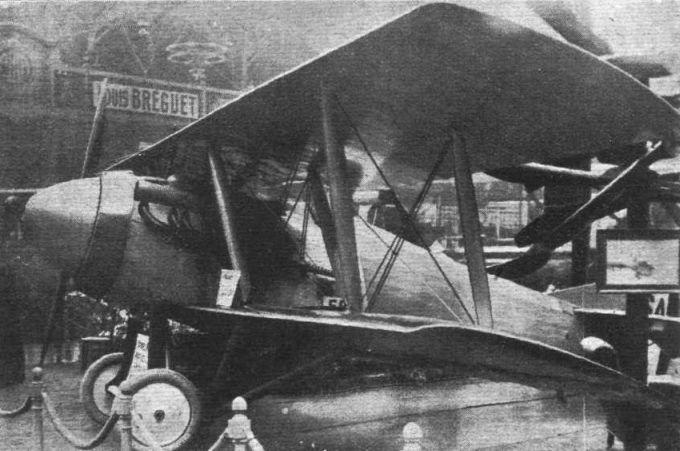
Flight, January 1920
The Paris Aero Show 1919
Pierre Levasseur
In addition to an extensive collection of airscrews, including some with variable pitch and one huge airscrew of about 40 ft. diameter, which latter has not, we are authorized to state, been fitted on the de Marcay ”Passe-Partout,” this well-known French constructor is exhibiting two complete machines. One of these is a standard Spad, built under licence, a machine which is so well known as to need no reference here beyond the statement of its presence on the stand.
The other machine is a war type which was to have come to the front but for the signing of the armistice. It is a single-seater fighter with 300 h.p. Hispano-Suiza engine. The fuselage is of stream line form, covered with aluminium in front and fabric in the rear. The armament consists of four machine guns, two of which are mounted above the body and synchronised in the usual way. The other two are placed in the top plane, some little distance out, and are operated by Bowden control. Whether there is actually any more certainty of hitting the target with an arrangement like this is, perhaps, open to doubt, but as a means for ensuring that, even in the case of one or more guns jamming, firing can still be maintained the idea would appear to have certain advantages.
The engine is totally enclosed in an aluminium cowl, and there is a large spinner over the propeller boss. The radiator is of unusual design, being of annular shape and totally surrounding the nose of the machine, as shown in the accompanying sketch.
The wing bracing is of unorthodox design, there being no struts connecting the top plane with the fuselage. The usual centre section struts are replaced by short lengths of lift wires, running from the body to the top of the first pair of inter-plane struts. From the lower ends of these struts, or rather from the bottom spars, two struts converge downwards and inwards, where they are attached to the lower member of the under carriage. The absence of centre-section struts and their bracing naturally leaves the pilot’s view unobstructed, but otherwise it would appear that there is no very great advantage to be derived from this arrangement.
A feature of the planes of the “Sab,” as the machine is styled, is that the top surface of both planes is covered with three-ply wood from the leading edge to the rear spar. Ailerons and elevators are balanced by having their leading edges arranged in the form of saw teeth, as shown in one of our sketches.
Описание:
- Flight, January 1920
The Paris Aero Show 1919 - Flight, December 1926
The Paris Aero Show 1926
Фотографии
-
Flight 1920-01 / Flight
The Pierre Levasseur S.A.B. fighter: This biplane has the top surface of its wings covered with three-ply wood
-
Flight 1920-01 / Flight
The Radiator of the Pierre Levasseur is of circular shape, and entirely surrounds the nose of the fuselage.
-
Flight 1920-01 / Flight
A French way of balancing the elevators. The tail of the P. Levasseur. On the right the inter-plane strut attachment.
-
Flight 1926-12 / Flight
The Salmson-Bechereau SRAP Commercial Aeroplane with 500 h.p. Salmson engine.
- Фотографии



